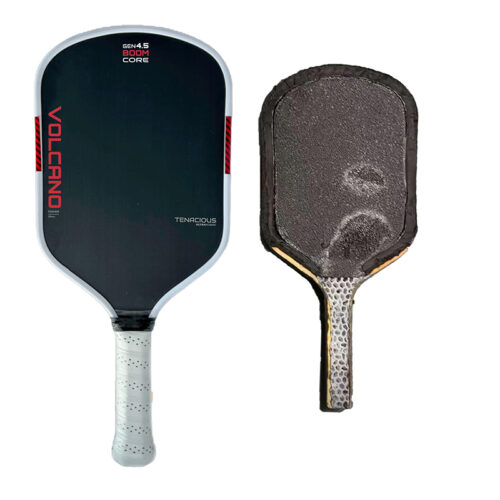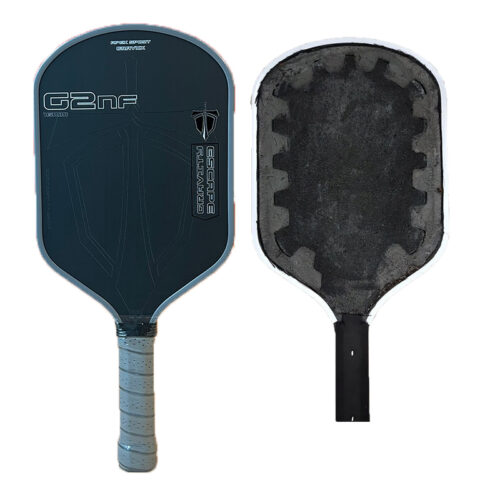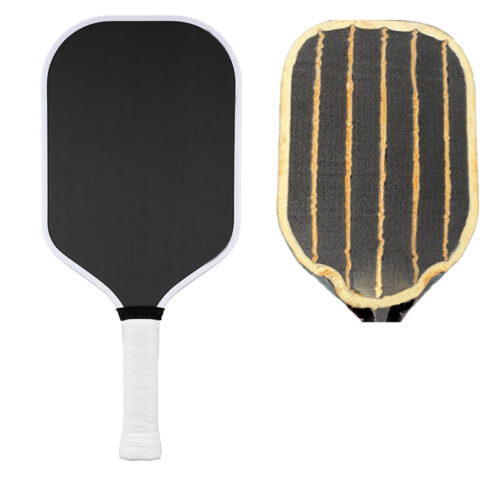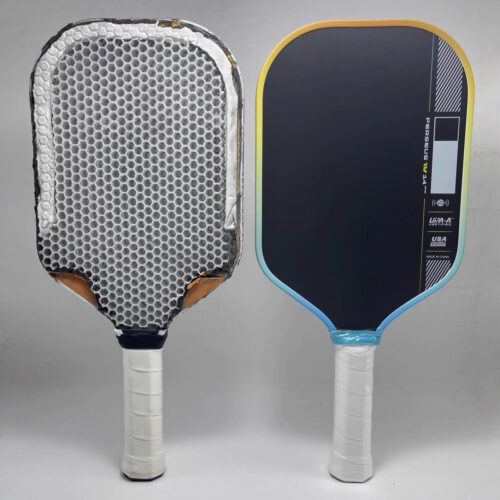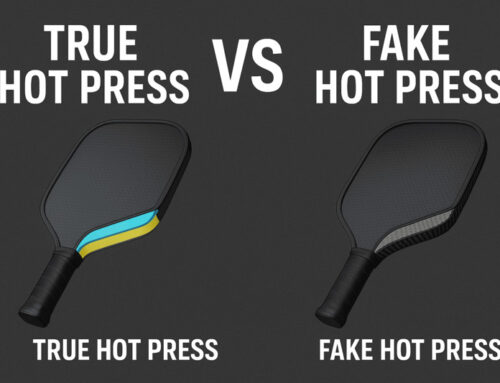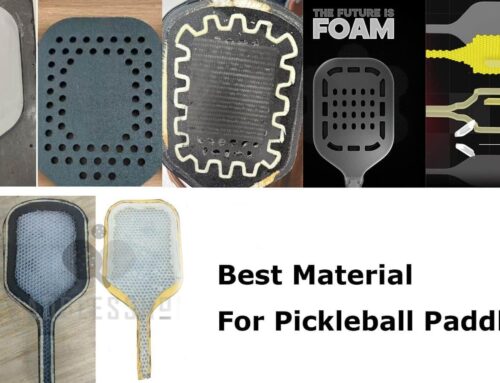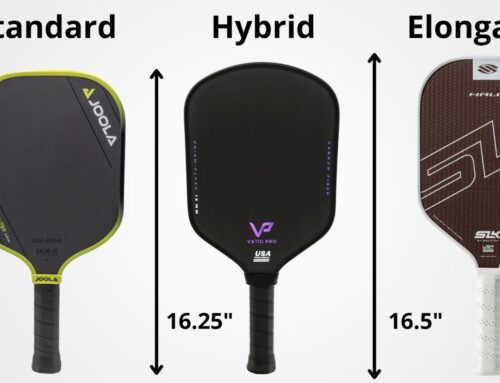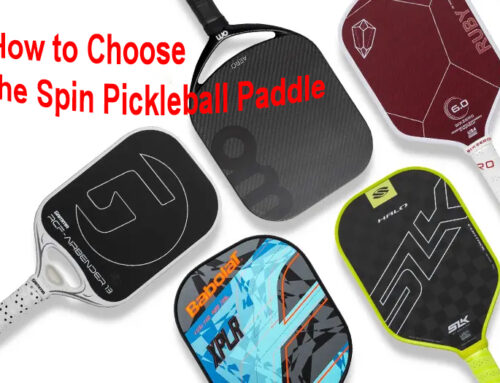In the world of pickleball, “carbon fiber” is synonymous with high quality. But while brands loudly promote “T700” or “T800” carbon fiber, we might be falling into a marketing trap. The true secret to your paddle’s performance isn’t just the carbon strands—it’s the soul of its weave.
As manufacturers deeply rooted in this industry, we know a hidden truth: two identical batches of carbon fiber, woven differently, can create paddles with completely different personalities. One might be rigid and powerful, the other soft and forgiving.
Let’s cut through the marketing jargon and uncover the core secret that defines a carbon fiber paddle’s true character.
01 Plain vs. Twill Weave: How Structure Defines Feel
Carbon fiber must be woven into a fabric before it can become a paddle. This weaving process is like defining the paddle’s personality, fundamentally determining its performance.
Plain Weave is the most classic structure. The warp and weft yarns cross over and under each other in a simple “one-over, one-under” pattern, creating a tight checkerboard.
On-Court Feel: It delivers an exceptionally crisp, direct “click” upon impact. Power transfer is immediate with almost no delay. It feels like a precision instrument, perfect for players who seek ultimate control and want to “read” every shot through their paddle.
Twill Weave represents a different philosophy. The yarns follow a “two-over, two-under” pattern, creating distinctive diagonal lines.
- On-Court Feel: It provides a unique “cushioned” or “pocketing” sensation. The ball seems to dwell on the surface for a fraction of a second longer, offering a softer, more elastic feel. It effectively filters out unwanted vibration, ensuring a comfortable, arm-friendly experience.
The technical differences between these weaves are clear:
| Feature | Plain Weave | Twill Weave |
|---|---|---|
| Structural Stability | Very High | High |
| Impact Feel | Crisp, Direct "Click" | Soft, Cushioned "Pocketing" |
| Vibration Dampening | Lower (can feel "harsh") | Excellent (Arm-Friendly) |
| Fiber Strength Utilization | ~85% | ~92% |
| Ideal Player | Control-Oriented, Competitive | Comfort-Seeking, Recreational |
02 Carbon Fiber Modulus: The Misunderstood Numbers Game
Beyond how it’s woven, we must consider what is being woven. The modulus (e.g., T300, T700, T800) is unavoidable, but it’s often misunderstood.
Simply put, the modulus measures the stiffness of the carbon filaments. A higher number means a stiffer, more brittle, and more expensive fiber. However, a higher modulus does not automatically mean a better paddle.
A paddle made entirely from T800 carbon could feel overly stiff and “dead,” lacking the nuanced feedback that players need. The real engineering magic lies in hybrid layering. High-end paddles intelligently combine different modulus fabrics in specific areas—using T700 in the rim for torsional stability and T300 in intermediate layers for damping and toughness.
Here’s a breakdown of common modulus grades:
| Modulus Grade | Tensile Strength | Key Characteristic | Common Use |
|---|---|---|---|
| T300 | ~3.5 GPa | Balanced Stiffness & Toughness | Base models, Hybrid layers |
| T700 | ~4.9 GPa | High Stiffness, High Rebound | Mainstream high-end paddles |
| T800 | ~5.6 GPa | Ultra-Stiff, Lightweight | Top-tier competitive paddles |
03 The Art of Hybridization: Smarter Material Combinations
When carbon fiber is combined with other materials, it creates a synergy where the whole is greater than the sum of its parts. This is a key strategy for creating differentiated products.
Carbon Fiber + Fiberglass is the most common hybrid.
- Purpose: To significantly improve toughness and vibration dampening while effectively controlling costs.
Result: It transforms the raw “pop” of pure carbon into a more forgiving and comfortable “soft pop,” ideal for the intermediate market.
Carbon Fiber + Kevlar® represents a niche, high-performance approach.
- Purpose: To leverage Kevlar’s legendary impact and tear resistance.
Result: It creates an incredibly durable paddle face that resists damage from impacts and offers a uniquely “Q-elastic” or lively feel.
The performance trade-offs are significant:
| Performance Aspect | Carbon + Fiberglass | Carbon + Kevlar |
|---|---|---|
| Impact Resistance | ~40% Improvement | ~150% Improvement |
| Vibration Dampening | Significant Improvement | Moderate Improvement |
| Cost Impact | 15-20% Reduction | 30-50% Increase |
| Feel | Soft, Comfortable | Unique, "Lively" |
04 The Right Choice: Tailoring Solutions to Player Needs
So, how do you choose the right material combination for different market needs?
- For the professional/control-focused market, a high-strength plain weave carbon construction is king. It provides the direct feedback and precision that advanced players demand.
- For the mainstream/comfort-focused market, a mid-modulus twill weave carbon is often the wiser choice. Its superior dampening and flexible nature ensure comfort during long play sessions.
- In balancing cost and performance, a plain T300 weave offers excellent value, while a twill T800 weave represents the pinnacle of performance. For a unique selling proposition, Carbon-Kevlar hybrids create a distinctive feel and unmatched durability.
A superior pickleball paddle is not born from simply stacking expensive materials. It is the result of a precise symphony of weaving patterns, modulus grading, and hybrid material science.
The End about Mayvoci
1)Design:Over 100 paddle designs and photography service to assist start-up.
2)Professional:Focus on various of paddles manufacturing for 6 years
3)Quality:Strict quality management system to provide safety and satisfaction for customers
4)Amazon:Flexible comprehensive solution to make sure each Amazon seller is well cared.
5)Excellent Team:Experienced paddle experts & dynamic sales team give you 5-star service

